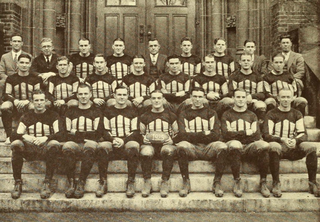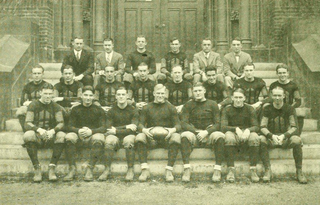Related Research Articles
The 1946 Massachusetts State Aggies football team represented Massachusetts State College in the 1946 college football season. The team was coached by Walter Hargesheimer and played its home games at Alumni Field in Amherst, Massachusetts. The 1946 season was the team's last as an Independent, as they would form the Yankee Conference with the other New England land-grant universities in 1947. It was also their last as the Mass State Aggies, as they would begin play in 1947 as the University of Massachusetts Redmen. Mass State finished the season with a record of 6–2.
The 1927 Massachusetts Aggies football team represented Massachusetts Agricultural College in the 1927 college football season. The team was a member of the New England Conference, although they did not play other teams in the conference this season. The team was coached by Harold Gore and played its home games at Alumni Field in Amherst, Massachusetts. The 1927 season was Gore's last with the Aggies, as he finished his coaching career with a record of 33–32–5. It was also their most recent winless season. Massachusetts finished the season with a record of 0–7–1.
The 1920 Massachusetts Aggies football team represented Massachusetts Agricultural College in the 1920 college football season. The team was coached by Harold Gore and played its home games at Alumni Field in Amherst, Massachusetts. Massachusetts finished the season with a record of 5–2–1.
The 1919 Massachusetts Aggies football team represented Massachusetts Agricultural College in the 1919 college football season. The team was coached by Harold Gore and played its home games at Alumni Field in Amherst, Massachusetts. The 1919 season was Gore's first as head coach of the Aggies and the team's first season since disbanding during World War I. Massachusetts finished the season with a record of 5–2–1.
The 1914 Massachusetts Aggies football team represented Massachusetts Agricultural College in the 1914 college football season. The team was coached by Arthur Brides and played its home games at Alumni Field in Amherst, Massachusetts. Massachusetts finished the season with a record of 2–5.
The 1908 Massachusetts Aggies football team represented Massachusetts Agricultural College in the 1908 college football season. The team was coached by Matthew W. Bullock and played its home games at Alumni Field in Amherst, Massachusetts. The 1908 season was Bullock's last as head coach of the Aggies. Massachusetts finished the season with a record of 3–3–3.
The 1905 Massachusetts Aggies football team represented Massachusetts Agricultural College in the 1905 college football season. The team was coached by Walter Craig and played its home games at Alumni Field in Amherst, Massachusetts. The 1905 season was Craig's only as head coach of the Aggies. Massachusetts finished the season with a record of 3–7.
The 1904 Massachusetts Aggies football team represented Massachusetts Agricultural College in the 1904 college football season. The team was coached by Matthew W. Bullock and played its home games at Alumni Field in Amherst, Massachusetts. The 1904 season was Bullock's first as head coach of the Aggies. He would leave the team following the season, but return to coach again in 1907. Massachusetts finished the season with a record of 5–2–1.
The 1903 Massachusetts Aggies football team represented Massachusetts Agricultural College in the 1903 college football season. The team was coached by James Halligan and played its home games at Alumni Field in Amherst, Massachusetts. The 1903 season was Halligan's last as head coach of the Aggies. Massachusetts finished the season with a record of 5–4.
The 1901 Massachusetts Aggies football team was an American football team that represented Massachusetts Agricultural College in the 1901 college football season. The team was coached by James Halligan and played its home games at Alumni Field in Amherst, Massachusetts. The 1901 season was Halligan's first as head coach of the Aggies. Massachusetts finished the season with a record of 9–1.
The 1900 Massachusetts Aggies football team represented Massachusetts Agricultural College in the 1900 college football season. The team was coached by Fred W. Murphy and played its home games at Alumni Field in Amherst, Massachusetts. The 1900 season was Brown's last as head coach of the Aggies. Massachusetts finished the season with a record of 5–5.
The 1899 Massachusetts Aggies football team represented Massachusetts Agricultural College in the 1899 college football season. The team was coached by Fred W. Murphy and played its home games at Alumni Field in Amherst, Massachusetts. The 1899 season was Brown's first as head coach of the Aggies. Massachusetts finished the season with a record of 7–3.
The 1925 Connecticut Aggies football team was an American football team that represented Connecticut Agricultural College, now known as the University of Connecticut, as a member of the New England Conference (NEC) during the 1925 college football season. In its third season under head coach Sumner Dole, Connecticut compiled a 3–5–1 record, going 0–3–1 against conference opponents.
The 1907 Utah Agricultural Aggies football team was an American football team that represented Utah Agricultural College as an independent during the 1907 college football season. In their first season under head coach Fred M. Walker, the Aggies compiled a 5–1 record and outscored opponents by a total of 156 to 25.

The 1925 Springfield Red and White football team was an American football team that represented Springfield College during the 1925 college football season. In its second season under head coach John L. Rothacher, the team compiled a 6–1–1 record, outscored opponents by a total of 145 to 52, and played its home games at Pratt Field in Springfield, Massachusetts. Boston Braves outfielder Leslie Mann served as an assistant coach.
The 1900 Holy Cross football team was an American football team that represented the College of the Holy Cross as an independent in the 1900 college football season.
The 1907 Holy Cross football team was an American football team that represented the College of the Holy Cross in the 1907 college football season.
The 1914 Holy Cross football team was an American football team that represented the College of the Holy Cross in the 1914 college football season.

The 1924 Springfield Red and White football team was an American football team that represented Springfield College as an independent during the 1924 college football season. Led by first-year head coach John L. Rothacher, Springfield compiled a record of 4–2–1. John B. Stoeber the team's captain. Springfield played their home games at Pratt Field in Springfield, Massachusetts.
The 1903 Springfield Training School football team was an American football team that represented the International Young Men's Christian Association Training School—now known as Springfield College–as an independent during the 1903 college football season. Led by ninth-year head coach James H. McCurdy, the team compiled a record of 1–3–1.
References
- ↑ "Dartmouth 6, M.A.C. 0". The Boston Globe. October 13, 1907. p. 12 – via Newspapers.com.
- ↑ "Goal from Field Won". The Brooklyn Daily Eagle . Brooklyn, N.Y. October 20, 1907. sect. 5, p. 7 – via Newspapers.com.